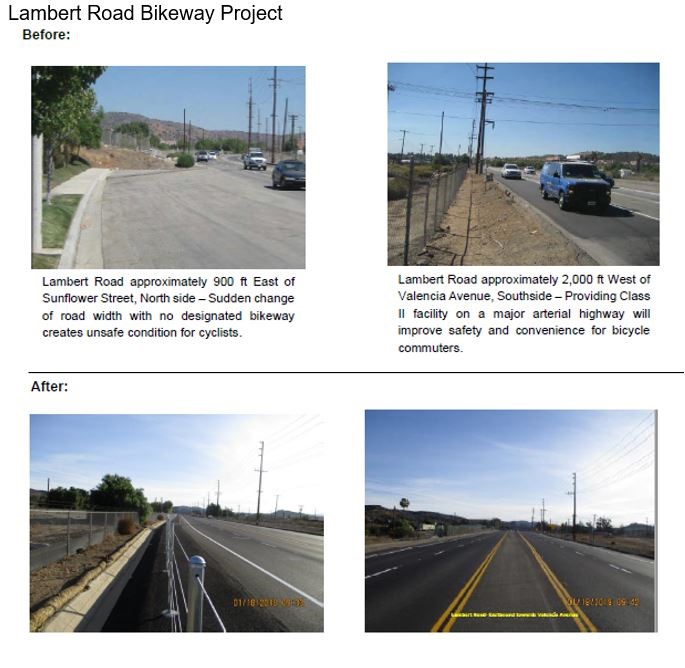
The Orange County Transportation Authority (OCTA) recently completed an extensive program to improve biking infrastructure throughout Orange County, thanks to $836,413 in Clean Transportation Funding from the MSRC. Four bikeways throughout the County were given facelifts by constructing new bikeways, installing lighting and upgrading the classes of bikeways to improve safety.
In the City of Irvine, the Freeway Trail Lighting Improvements Project was completed on the Culverdale Trail, located north of the Interstate 405 Freeway running parallel to the 405 and Main Street, from San Diego Creek to Culver Drive. This 6,000-foot section of the trail received new pole-mounted trail lights along the Class I bike path, to make biking and walking safer. Freeway Trail is well-traversed, as it provides access to community parks, residential communities, retail centers and business parks, so installing new lighting was critical. Prior to this project, there was no lighting on the trail in this area. Although there were existing streetlights along parallel Main Street, the cyclists would have to share the road with vehicles travelling at speeds of up to 50 miles per hour which at times makes it difficult for cars to see them.
The San Juan Capistrano Bicycle Lanes Gap Closure Project made improvements to increase bicycle and walking accessibility, reduce automobile use, and improve air quality to enhance connectivity and safety throughout the City. This project included a total of 2.1 miles of new bikeways and improvements in five different locations, including installing sharrows, new signage and pavement markings, upgraded asphalt paving, and trail fencing.

Located near the City of Brea, the Lambert Road Bikeway Project (see photo) built a new five-foot wide Class II bikeway in both directions along Lambert Road/Carbon Canyon Road between Sunflower Street and the entrance to Carbon Canyon Regional Park at Santa Fe Road. The completed project now provides improved safety for riders and connectivity to the adjacent bike routes, as well as to community amenities like parks and local schools.
In the City of Cypress, the Cerritos Avenue Bike Corridor Improvement Project upgraded the previously existing Class III bike infrastructure to a one-mile Class I bike path on the south side of Cerritos Avenue. A Class II facility on both sides of Cerritos Avenue from Denni Street to Walker Street also was upgraded. The bikeway needed to be upgraded because the Class III bikeway was ill-suited for the roadway’s high motor traffic speeds. A dedicated bikeway was built to promote continuity to the bikeway network and provide exclusive right-of-way for cyclists separate from the roadway, which minimizes cross flows by motor traffic. The project also enhanced the existing pedestrian path by installing a landscaped buffer to separate walkers and bikers to reduce pedestrian-cyclist conflicts.
By improving bikeway connections, these projects encourage residents to get out of their cars and onto their bikes or to walk, replacing vehicle trips, thereby reducing greenhouse gas emissions and improving local air quality. It also improves the safety of bicycle commuters and encourages active transportation which creates healthier communities for everyone.
